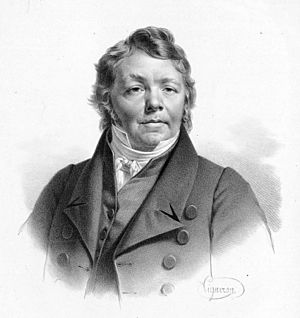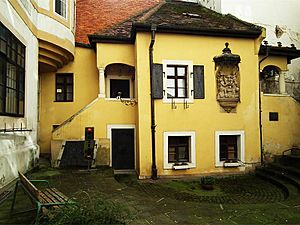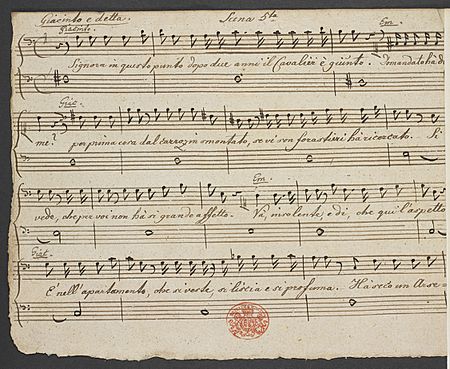Johann Nepomuk Hummel facts for kids
Quick facts for kids
Johann Nepomuk Hummel
|
|
|---|---|

Portrait by Joseph Karl Stieler, 1820
|
|
| Born | 14 November 1778 |
| Died | 17 October 1837 (aged 58) |
| Occupation | Composer and pianist |
|
Works
|
List of compositions |
| Spouse(s) | Elisabeth Röckel (m. 1813) |
| Children | Eduard, Carl |
Johann Nepomuk Hummel (born November 14, 1778 – died October 17, 1837) was an amazing Austrian composer and a super talented pianist. His music shows the change from the Classical music style to the Romantic style. He learned from famous composers like Mozart, Salieri, and Clementi. He also knew and was friends with Beethoven and Schubert.
Contents
Life
Early Years
Johann Hummel was born in Pressburg, which was part of the Kingdom of Hungary (now Bratislava, Slovakia). He was the only child in his family. He was named after a Czech saint, John of Nepomuk. His father, Johannes Hummel, was a music director in Vienna. His mother, Margarethe Sommer Hummel, had been married before.
Johann was a true child genius when it came to music. When he was just eight years old, the famous composer Wolfgang Amadeus Mozart was so impressed by his skills that he offered to teach him. Hummel lived with Mozart and learned from him for two years, all for free! He played his first concert at age nine, at one of Mozart's own shows.
After this, Hummel's father took him on a music tour around Europe. They went to London, where Hummel studied with Muzio Clementi for four years. Later, Joseph Haydn was also in London and wrote a sonata just for Hummel. Hummel played it for the first time with Haydn watching. Haydn was so pleased that he gave the young musician a gold coin.
A big event called the French Revolution stopped Hummel from touring Spain and France. So, he went back to Vienna, playing concerts along the way. In Vienna, he continued his music studies with Johann Georg Albrechtsberger, Joseph Haydn, and Antonio Salieri.
Around this time, a young Ludwig van Beethoven also came to Vienna to study with Haydn and Albrechtsberger. They became classmates and friends. Beethoven's arrival made Hummel feel a bit unsure of himself at first, but he soon got his confidence back. Their friendship had its ups and downs, but they ended up respecting each other a lot. Hummel even played music at Beethoven's memorial concert. There, he met Franz Schubert, who dedicated his last three piano sonatas to Hummel. However, because both composers had passed away, the publishers later changed the dedication to Robert Schumann.
Music Career
In 1804, Hummel became the Konzertmeister (a lead musician) for Prince Esterházy at Eisenstadt. He took on many duties of the main music director, or Kapellmeister, because Haydn was not well enough to do them himself. Out of respect for Haydn, Hummel was only called Kapellmeister after Haydn died in 1809. He worked for Prince Esterházy for seven years. He was let go in 1811 because he wasn't always doing his duties.
Hummel then went back to Vienna and spent two years composing music. In 1813, he married the opera singer Elisabeth Röckel. The next year, they toured Russia and other parts of Europe. They had two sons. Their younger son, Carl, became a famous painter. Their older son, Eduard, was a pianist and conductor. Eduard was even one of the people who carried Beethoven's coffin at his funeral.
Later, Hummel became the music director in Stuttgart (1816–1818) and then in Weimar (1819–1837). In Weimar, he became good friends with the famous writer Johann Wolfgang von Goethe. Hummel helped make Weimar a very important music city in Europe. He invited the best musicians to visit and play there. He also started one of the first pension plans for musicians. This helped musicians save money for retirement. Hummel was also one of the first people to fight for copyright for music. This meant that composers should own their music and get paid for it.
In 1825, a music company in Paris bought the rights to publish all of Hummel's future music in France. In 1830, Hummel played three concerts in Paris. At one of them, a piece by Hummel was played by Louise Farrenc, a composer who also asked Hummel for advice on her piano playing.
By 1832, Hummel was 54 and not in good health. He started to do less work as music director in Weimar. After Goethe died that year, Hummel also spent less time with local theater groups. He was mostly retired from 1832 until he passed away in 1837.
Later Years and Impact
Towards the end of his life, Hummel saw new, younger composers and pianists becoming popular. His own music, which was very neat and classical, started to go out of style. It was different from the wilder, more emotional music that was becoming popular. Hummel composed less, but he was still highly respected. He died peacefully in Weimar in 1837. Hummel was a Freemason, like Mozart. He left a large part of his garden to his Freemason lodge. His grave is in the Historical Cemetery, Weimar.
Even though Hummel was famous when he died, his music was quickly forgotten as the Romantic period of music took over. People thought his classical ideas were old-fashioned. Later, in the early 1900s, when classical music became popular again, Hummel was still overlooked. Like Haydn, he was overshadowed by Mozart and especially Beethoven, who lived at the same time. But now, with more recordings and concerts, Hummel's music is becoming popular again in classical music.
Some of his important students included Ferdinand Hiller and Alexander Müller.
His Music
Hummel's music took a different path from Beethoven's. Hummel's pieces, like his Sonata in F-sharp minor, Op. 81, and his Fantasy, Op. 18, were very modern for their time. In these works, Hummel pushed the boundaries of classical music rules and stretched the usual sonata form.
Most of Hummel's music is for the piano, as he was one of the best pianists of his time. He wrote eight piano concertos (pieces for piano and orchestra) and a double concerto for violin and piano. He also wrote ten piano sonatas, eight piano trios, and many other pieces for groups of instruments. He even wrote a Trumpet Concerto for the keyed trumpet and a "Grand Bassoon Concerto."
Hummel also wrote 22 operas and Singspiels (German operas with spoken dialogue), and masses (religious music). He was very interested in the guitar and wrote many pieces for it, often combining it with other instruments.
It's interesting that Hummel did not write any symphonies. His first two piano concertos were early works, similar to Mozart's style. The later six concertos were published with opus numbers. You can find a full list of Hummel's works online.
How He Influenced Others
In Germany, Hummel published a very important book in 1828 called A Complete Theoretical and Practical Course of Instruction on the Art of Playing the Piano Forte. This book sold thousands of copies quickly. It introduced new ways of using fingers on the piano and playing musical decorations. Later piano playing in the 1800s was influenced by Hummel. This happened through his student Carl Czerny, who then taught the famous Franz Liszt. Liszt greatly admired Hummel's work and often played his music.
Hummel's influence can also be seen in the early works of Frédéric Chopin and Robert Schumann. For example, Hummel's Piano Concerto in B minor and his Piano Concerto in A minor seem to have inspired Chopin's own concertos. This is not surprising, as Chopin likely heard Hummel play during his tours. Chopin also kept Hummel's piano concertos in his own list of pieces to play. A music historian, Harold C. Schonberg, wrote that the beginnings of Hummel's A minor concerto and Chopin's E minor concerto are "too close to be coincidental."
Robert Schumann also practiced Hummel's music, especially the Sonata in F-sharp minor, Op. 81. Schumann even thought about becoming Hummel's student. Liszt's father, Adam, did not want to pay Hummel's high teaching fees, so Liszt ended up studying with Czerny instead. Many other important pianists were Hummel's students, including Czerny, Ferdinand Hiller, and Sigismond Thalberg. He also gave some lessons to Felix Mendelssohn for a short time.
See also
 In Spanish: Johann Nepomuk Hummel para niños
In Spanish: Johann Nepomuk Hummel para niños






